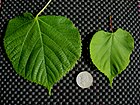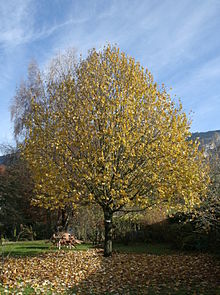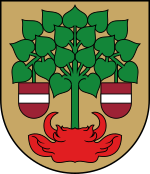Tilia cordata
| Tilia cordata | |
|---|---|

| |
| Scientific classification | |
| Kingdom: | Plantae |
| Clade: | Tracheophytes |
| Clade: | Angiosperms |
| Clade: | Eudicots |
| Clade: | Rosids |
| Order: | Malvales |
| Family: | Malvaceae |
| Genus: | Tilia |
| Species: | T. cordata
|
| Binomial name | |
| Tilia cordata | |

| |
| Distribution map | |
Tilia cordata, the small-leaved lime or small-leaved linden, is a species of tree in the family Malvaceae, native to much of Europe. Other common names include little-leaf or littleleaf linden,[2] or traditionally in South East England, pry or pry tree.[3] Its range extends from Britain through mainland Europe to the Caucasus and western Asia. In the south of its range it is restricted to high elevations.[4][5]
Description

Tilia cordata is a
Ecology
The trees favour good, loamy sites, but can also be found on sandy, infertile soils, and are not thought to be drought resistant. Dormant shoots of Tilia cordata can resist winter frost temperatures as low as −34 °C.[9]
Trees in northern England were found to have established when the climate was warmer and have adapted to the cooling climate.
Pests and diseases
The tree is fairly disease-resistant, though a common problem is
Cultivation and uses


Tilia cordata is widely grown as an
Tilia cordata survives best in a soil pH range of 5.0 to 8.0.[20] and in USDA Hardiness Zones 3–7.[21] The tree prefers moist, well drained soil, but can survive flooding; it is not highly drought tolerant.[16] It does not do well in soils with high salinity.[22]
Notable trees
The
Hybrids
- Common lime: T. cordata readily hybridises with Tilia platyphyllos; the hybrid is commonly known as common lime, Tilia × europaea (syn. T. × vulgaris).[4][24]
Cultivars
- 'Corinthian' ('Corzam') – dense, uniform limb spacing creates a compact, pyramidal, formal shape; darker and smaller leaves; resistant to Japanese beetles.[21]
- 'Greenspire' – the most common, a cross between the cultivar 'Euclid' and a selection from the Boston Parks, broadly used as a street tree, survives better under difficult conditions, overall a good looking, quick growing tree.[21]
- 'June Bride' – significantly pyramidal habit, evenly spaced branches around a very straight central leader, glossier leaves, and 3 to 4 times as many flowers.[21]
- 'Winter Orange' – rich red-orange-brown stems with reddish buds, can be cut back to grow long shoot extensions. It has gained the Royal Horticultural Society's Award of Garden Merit.[25][26]
Linden flower tea


In the countries of Central, Southern and Western Europe, linden flowers are a traditional herbal remedy made into an herbal tea called lime tea[27] or linden tea in Britain, tilleul in France,[28] tila in Spain.
Honey
A monofloral
Leaves
The young leaves can be eaten as a salad vegetable.[29] Cattle often graze upon them.[28]
Linden wood
The white, finely-grained
Cultural significance

Tilia cordata is the
The leaf of Tilia cordata is also considered a national symbol of Slovenia.[citation needed]References
- . Retrieved 16 July 2023.
- ^ USDA, NRCS (n.d.). "Tilia cordata". The PLANTS Database (plants.usda.gov). Greensboro, North Carolina: National Plant Data Team. Retrieved 10 December 2015.
- ^ "pry, n.1." OED Online, Oxford University Press, December 2020, http://oed.com/view/Entry/153661. Accessed 7 January 2021
- ^ ISBN 0-00-220013-9.
- ISBN 978-1-4746-1404-7.
- ^ "Den virtuella floran – stängd för ombyggnad". Linnaeus.nrm.se. Archived from the original on 2019-05-26.
- ^ ISBN 978-0030818639.
- ^ http://ip30.eti.uva.nl/BIS/flora.php?selected=beschrijving&menuentry=soorten&id=2132 [permanent dead link]
- ^ Jensen, J.S. (2003). "Lime - Tilia spp" (PDF). EUFORGEN Technical Guidelines for Genetic Conservation and Use: 6 p. Archived from the original (PDF) on 2017-01-31. Retrieved 2017-01-19.
- ^ Natural England internal website
- ^ Woodland Trust The test-tube tree, Broadleaf Anon, Spring 2014, p. 7
- ^ Natural England Citation dated 12 May 1986, Sssi.naturalengland.org.uk
- ^ Woodland Trust Giant seed hunt to revitalize woods, Broadleaf Anon, Spring 2014, p. 9
- .
- JSTOR 2556763.
- ^ a b Gilman, Edward; Watson, Dennis. "Tilia cordata Littleleaf Linden" (PDF). Archived from the original (PDF) on 2012-07-16. Retrieved 28 February 2014.
- ^ "Gypsy moth". Natural Resources Canada. 31 December 2013. Retrieved 20 April 2021.
- ^ Phillips, Leonard E. Jr. (1993). Joel Stein (ed.). Urban Trees: A Guide for Selection, Maintenance, and Master Planning. United States of America: McGraw-Hill. p. 259.
- ^ "Bonsai Focus". Archived from the original on 2014-02-28. Retrieved 27 February 2014.
- ^ "Soil pH Trees and Shrubs and what they like" (PDF). Archived from the original (PDF) on 2014-03-07. Retrieved 22 February 2014.
- ^ ISBN 978-1-58874-868-3.)
{{cite book}}:|work=ignored (help)CS1 maint: location missing publisher (link - ^ Kotuby-Amacher, Jan (March 2000). "Salinity and Plant Tolerance" (PDF). Electronic Publishing. pp. 1–8. Archived from the original (PDF) on 7 March 2014. Retrieved 28 February 2014.
- ^ Šmid Hribar, Mateja. "Najevska lipa" [Najevnik Linden Tree]. In Šmid Hribar, Mateja; Golež, Gregor; Podjed, Dan; Kladnik, Drago; Erhartič, Bojan; Pavlin, Primož; Ines, Jerele (eds.). Enciklopedija naravne in kulturne dediščine na Slovenskem – DEDI [Encyclopedia of Natural and Cultural Heritage in Slovenia] (in Slovenian). Retrieved 28 August 2013.
- ^ http://ip30.eti.uva.nl/BIS/flora.php?selected=beschrijving&menuentry=soorten&id=2131 [permanent dead link]
- ^ "RHS Plantfinder - Tilia cordata 'Winter Orange'". Retrieved 23 December 2018.
- ^ "AGM Plants - Ornamental" (PDF). Royal Horticultural Society. July 2017. p. 102. Retrieved 23 December 2018.
- ^ "Wild Food UK", Wildfooduk.com
- ^ a b c Grieve, M. "Lime Tree". Botanical.com.
- ^ Vernon, J. (2007). Fruits of the forest. The Garden November 2007: 738. Royal Horticultural Society.
- ^ Williams SWCD (16 February 2005). "Little leaf linden is fragrant". The Bryan Times. p. 11. Retrieved 28 February 2014.
- ^ Aberystwyth University campus walks tree directory (PDF). Aberystwyth University sports centre. p. 9. Archived from the original (PDF) on 2012-10-02. Retrieved 2011-08-14.
- ^ "Archived copy" (PDF). www.videsgidi.lv. Archived from the original (PDF) on 18 September 2017. Retrieved 22 May 2022.
{{cite web}}: CS1 maint: archived copy as title (link)
External links
- Tilia cordata – distribution map, genetic conservation units and related resources. European Forest Genetic Resources Programme (EUFORGEN)

